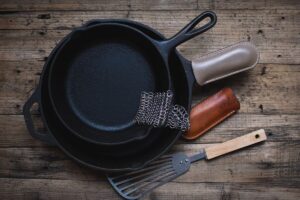Ceramic cookware has gained significant popularity in recent years, celebrated for its aesthetic appeal, health benefits, and excellent cooking performance.
This guide explores the advantages, care instructions, and considerations for ceramic cookware, helping you make an informed decision for your kitchen.
What is Ceramic Cookware?
Ceramic cookware is typically made from a base material such as aluminum or stainless steel, which is then coated with a layer of ceramic. This ceramic coating is derived from natural minerals and sand, offering a non-toxic and eco-friendly cooking surface.
Benefits of Ceramic Cookware
1. Non-Toxic and Eco-Friendly: Ceramic cookware is free from harmful chemicals such as PTFE, PFOA, lead, and cadmium. This makes it a healthier option compared to traditional non-stick cookware, which may release toxic fumes when overheated.
2. Non-Stick Properties: The ceramic coating provides a non-stick surface, allowing you to cook with less oil or butter. This can contribute to healthier meals and easier cleanup.
3. Even Heat Distribution: Ceramic cookware ensures even heat distribution, reducing the risk of hot spots that can burn food. This results in more consistent cooking outcomes and better-tasting dishes.
4. Versatility: Ceramic cookware is versatile and can be used on various heat sources, including gas, electric, and induction stovetops. Many ceramic pieces are also oven-safe, making them suitable for a wide range of cooking techniques.
5. Aesthetic Appeal: With its smooth, glossy finish and vibrant colors, ceramic cookware adds a touch of elegance to any kitchen. It’s also available in a variety of styles and designs to suit different preferences.
Caring for Ceramic Cookware
Proper care is essential to maintain the performance and appearance of ceramic cookware. Here are some tips to help you get the most out of your investment:
1. Seasoning: While not always necessary, seasoning your ceramic cookware can enhance its non-stick properties. Simply coat the surface with a thin layer of oil and heat it on low for a few minutes before the first use.
2. Cooking Temperature: Avoid using high heat settings, as extreme temperatures can damage the ceramic coating. Medium to low heat is generally sufficient for most cooking tasks.
3. Utensils: Use wooden, silicone, or plastic utensils to prevent scratching the ceramic surface. Avoid metal utensils, which can cause damage.
4. Cleaning: Allow the cookware to cool before washing. Hand wash with a soft sponge and mild detergent. Avoid abrasive cleaners or scouring pads, as they can scratch the ceramic coating.
5. Storage: Store ceramic cookware with care to prevent chipping or scratching. If stacking is necessary, place a soft cloth or paper towel between each piece.
Considerations When Choosing Ceramic Cookware
When selecting ceramic cookware, consider the following factors to ensure you choose the best option for your needs:
1. Quality: Invest in high-quality ceramic cookware from reputable brands. Cheaper options may have inferior coatings that wear out quickly.
2. Weight: Ceramic cookware can be heavier than other types of cookware. Ensure that the weight is manageable for your cooking and handling needs.
3. Price: While ceramic cookware can be more expensive than other options, its durability and health benefits often justify the cost. Consider it a long-term investment for your kitchen.
4. Compatibility: Check that the ceramic cookware is compatible with your stovetop, especially if you have an induction cooktop.
Conclusion
Ceramic cookware is a fantastic addition to any kitchen, offering a combination of health benefits, cooking performance, and aesthetic appeal.
By understanding its advantages, caring for it properly, and considering key factors when making a purchase, you can enjoy the many benefits of ceramic cookware for years to come.





